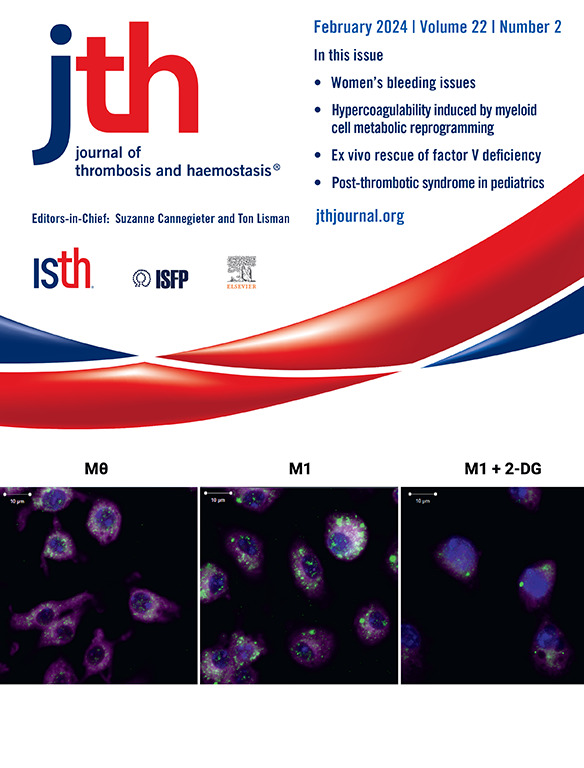在各种FVIII来源存在的情况下,FVIII中和的标准化用于功能性Emicizumab量化。
IF 5
2区 医学
Q1 HEMATOLOGY
引用次数: 0
摘要
背景:普通人群缺血性卒中后静脉血栓栓塞(VTE)的数据有限。我们的目的是在人群水平上探讨缺血性卒中对静脉血栓栓塞、静脉血栓栓塞亚型和性别的影响,并评估1994-2007年和2008-2019年间卒中相关静脉血栓栓塞的风险是否发生变化。方法:从特罗姆瑟研究(1994-2008)的三项调查和特朗德莱格健康研究(1995-2008)的两项调查中招募参与者(n= 107321),分别随访至2014年和2019年。采用Cox模型计算静脉血栓栓塞的风险比(hr),卒中为时变暴露。静脉血栓栓塞的累积发生率以死亡作为竞争事件进行估计。结果:5974人被诊断为缺血性卒中,其中199人在随访期间发生静脉血栓栓塞。卒中后3个月内,女性静脉血栓栓塞的累积发病率和HR分别为1.13%和13.47 (95%CI:9.41-19.27),男性为0.76%和9.50 (95%CI: 6.38-14.14)。卒中使诱发性静脉血栓栓塞的风险增加19倍(HR 18.67;95% CI:14.01-24.88),非诱发性静脉血栓栓塞风险增加3倍(HR 3.05;95% CI:1.45-6.45)。卒中后静脉血栓栓塞的风险估计在两个时间段之间没有变化。结论:女性静脉血栓栓塞的性别特异性风险估计值仅略高于男性。缺血性卒中与诱发性静脉血栓栓塞的风险特别高相关,强调了其他危险因素的增强作用。在过去的几十年里,缺血性卒中后静脉血栓栓塞的风险并没有下降。本文章由计算机程序翻译,如有差异,请以英文原文为准。
Impact of ischemic stroke on the risk of venous thromboembolism in the general population: the Tromsø Study and the Trøndelag Health Study
Background
Data on venous thromboembolism (VTE) after ischemic stroke in the general population is limited.
Objectives
We aimed to explore the impact of ischemic stroke on overall VTE and VTE subtypes and by biological sex at the population level and to evaluate whether the risk of stroke-related VTE changed between 1994-2007 and 2008-2019.
Methods
Participants (N = 107 321) were recruited from 3 surveys of the Tromsø Study (enrollment:1994-2008) and 2 surveys of the Trøndelag Health Study (enrollment:1995-2008) and followed through 2014 and 2019, respectively. Hazard ratios (HRs) of VTE were calculated using Cox models with stroke as time-varying exposure. Cumulative incidences of VTE were estimated with death as a competing event.
Results
Ischemic stroke was diagnosed in 5974 individuals, of whom 199 developed VTE during follow-up. Within 3 months poststroke, the cumulative incidence and HR of VTE was 1.13% and 13.47 (95% CI, 9.41-19.27) in women and 0.76% and 9.50 (95% CI, 6.38-14.14) in men, respectively. Stroke conferred a 19-fold increased risk of provoked VTE (HR, 18.67; 95% CI, 14.01-24.88) and a 3-fold increased risk of unprovoked VTE (HR, 3.05; 95% CI, 1.45-6.45) within 3 months. The risk estimates of VTE after stroke did not change between the 2 time periods.
Conclusion
Sex-specific risk estimates for VTE were only marginally higher in women than in men. Ischemic stroke was associated with particularly high risk of provoked VTE, emphasizing the potentiating effect of additional risk factors. The risk of VTE after ischemic stroke has not declined over the past decades.
求助全文
通过发布文献求助,成功后即可免费获取论文全文。
去求助
来源期刊
CiteScore
24.30
自引率
3.80%
发文量
321
审稿时长
1 months
期刊介绍:
The Journal of Thrombosis and Haemostasis (JTH) serves as the official journal of the International Society on Thrombosis and Haemostasis. It is dedicated to advancing science related to thrombosis, bleeding disorders, and vascular biology through the dissemination and exchange of information and ideas within the global research community.
Types of Publications:
The journal publishes a variety of content, including:
Original research reports
State-of-the-art reviews
Brief reports
Case reports
Invited commentaries on publications in the Journal
Forum articles
Correspondence
Announcements
Scope of Contributions:
Editors invite contributions from both fundamental and clinical domains. These include:
Basic manuscripts on blood coagulation and fibrinolysis
Studies on proteins and reactions related to thrombosis and haemostasis
Research on blood platelets and their interactions with other biological systems, such as the vessel wall, blood cells, and invading organisms
Clinical manuscripts covering various topics including venous thrombosis, arterial disease, hemophilia, bleeding disorders, and platelet diseases
Clinical manuscripts may encompass etiology, diagnostics, prognosis, prevention, and treatment strategies.

 求助内容:
求助内容: 应助结果提醒方式:
应助结果提醒方式:


